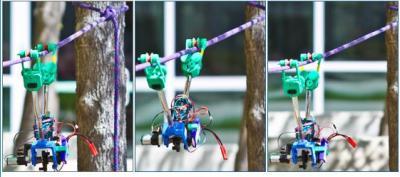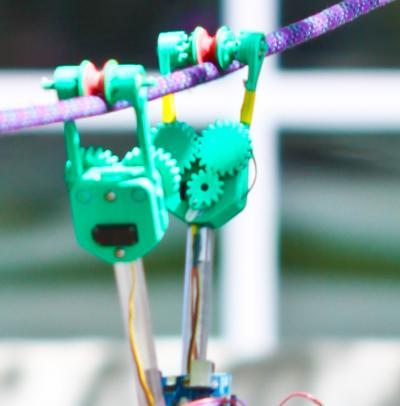Mechanical engineers at the University of California, San Diego invented a robot designed to scoot along utility lines, searching for damage and other problems that require repairs. Made of off-the-shelf electronics and plastic parts printed on an inexpensive 3D printer, the SkySweeper prototype could be scaled up for less than $1,000, making it significantly more economical than the two models of robots currently used to inspect power lines.
"Current line inspection robots are large, complex, and expensive. Utility companies may also use manned or unmanned helicopters equipped with infrared imaging to inspect lines," said Nick Morozovsky, a graduate student in mechanical engineering at UC San Diego, who designed the robot. "This is much simpler."

SkySweeper is V-shaped with a motor-driven "elbow" and its ends are equipped with clamps that open and close as necessary to move it down utility lines, searching for damage, inch by inch. It was designed by graduate student Nick Morozovsky in the Coordinated Robotics Lab led by mechanical and aerospace engineering professor Tom Bewley.
(Photo Credit: Photo : UC San Diego Jacobs School of Engineering.)
Morozovsky, who works in the lab of Professor Thomas Bewley at the Jacobs School of Engineering at UC San Diego, will introduce the robot at the International Conference on Intelligent Robots and Systems, also known as IROS 2013, from Nov. 3 to 8 in Tokyo. He will also present a paper, titled "A Low Degrees of Freedom, Dynamic High Wire Robot," at the conference.
SkySweeper is V-shaped with a motor-driven "elbow" in the middle and its ends are equipped with clamps that open and close as necessary to move it down the line, inch by inch. Morozovsky is strengthening the clamps so they can release from the rope and swing down the line, one end to the other, thereby swinging past cable support points.
You can watch the robot in action here: http://bit.ly/16vpFnO
SkySweeper could be outfitted with induction coils that would harvest energy from the power line itself, making it possible for the robot to stay deployed for weeks or months at a time. It could also be equipped with a mounted camera, which would transmit images to an inspection crew.

SkySweeper is V-shaped with a motor-driven "elbow" and its ends are equipped with clamps that open and close as necessary to move it down utility lines, searching for damage, inch by inch. It was designed by graduate student Nick Morozovsky in the Coordinated Robotics Lab led by mechanical and aerospace engineering professor Tom Bewley.
(Photo Credit: Photo : UC San Diego Jacobs School of Engineering.)